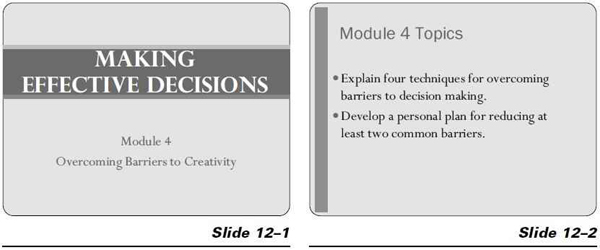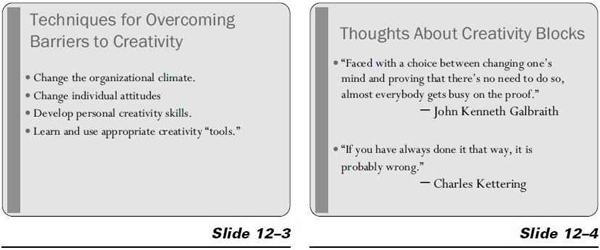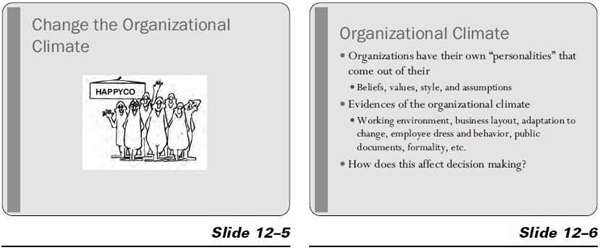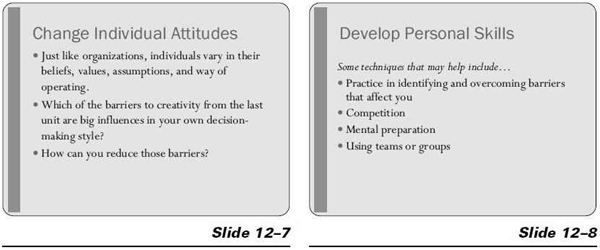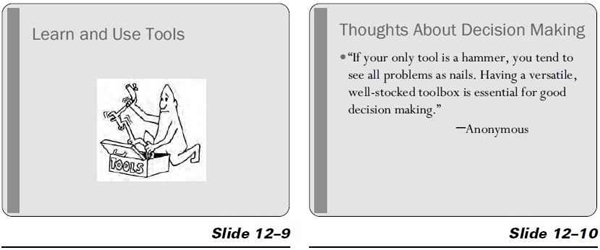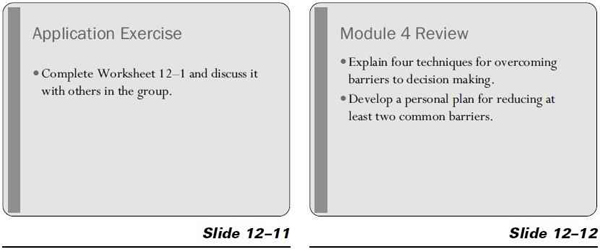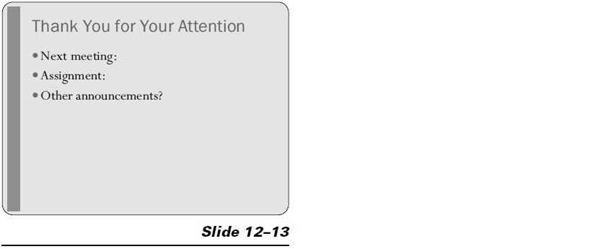C h a p t e r 1 2
Module 4—Overcoming
Barriers to Creativity
Module 4 looks closely at ways to overcome the barriers to creativity that were identified in module 3. It is recommended for any session in which the training program lasts more than one day, and it needs to follow module 3 in sequence.
Training Objectives
After completing this module, the participants should be able to
- explain four techniques for overcoming barriers to decision making
- develop a personal plan for reducing at least two of the common barriers to creativity.
 Module 4 Time
Module 4 Time
- Approximately 1 hour
| Introduction, welcome, and review of previous modules | 5 minutes |
| PowerPoint presentation and group discussion | 30 minutes |
| Worksheet: application exercise | 20 minutes |
| Wrap-up, learning check, and preview | 5 minutes |
Note: This includes time for a quick review at the start and a learning check at the end.
Materials
- Attendance list
- Pencils, pens, and paper for each participant
- Whiteboard or flipchart and markers
- Name tags or name tents for each participant
- Worksheet 12–1: Overcoming Creativity Barriers
- Computer, screen, and projector for displaying PowerPoint slides; alternatively, overhead projector and overhead transparencies
- PowerPoint slide program (slides 12–1 through 12–12)
- This chapter for reference or detailed facilitator notes
- Optional: music, coffee, or other refreshments.
Module Preparation
Arrive ahead of time to greet the participants, and make sure materials are available and laid out appropriately for the way you want to run the class.
Sample Agenda
| 0:00 | Welcome the class. |
| Have slide 12–1 up on the screen as participants arrive; go to slide 12–2 as you begin. | |
| Preview the agenda for this session (the objectives). | |
| Ask for questions or concerns. | |
| 0:05 | PPT Presentation. |
| Begin with slide 12–3; pause for discussion, then proceed through slide 12–9. (Note that slides 12–6 and 12–7 also include questions for discussion.) | |
| 0:35 | Worksheets. Distribute Worksheet 12–1: Overcoming Creativity Barriers. |
| Show slide 12–10 as the participants work on the worksheet. | |
| Move among participants to keep them on task. | |
| Have participants discuss answers with others. | |
| 0:55 | Wrap-up. |
| Show slide 12–11. Review the objectives with participants. | |
| Ask for questions. | |
| Check for learning; questions can be in oral or printed form (see below). | |
| Show slide 12–12. Dismiss the class. |
 Trainer’s Notes
Trainer’s Notes
8:00 a.m. Welcome (5 minutes).
Show slide 12–1 as participants arrive.
Take care of housekeeping items.
8:05 a.m. Techniques for Overcoming Barriers to Creativity (30 minutes).
Show slide 12–2, and preview the topics in module 4.
Show slide 12–3.
Tell the participants that some of the reasons we don’t exercise our creativity is that the organizational climate or personal barriers often discourage creativity. We may be afraid of making mistakes, or even of losing our jobs, if we are too creative.
How much an individual can personally do to change the climate depends in part on where he or she is within the organization’s hierarchy. It also depends on that person’s leadership skills. Someone who runs the organization (or a portion of it), probably can have a big influence on the climate. A person who is part of an employee group such as a self-managed work team (or participative management teams by whatever name) in an organization is probably open to the idea of change. But for most of us, changing the organizational climate is a difficult proposition.
Show slide 12–4. Review the Galbraith and Kettering quotes with the participants.
Show slide 12–5. Discuss with participants what that term means to them. It is explained on the following slide.
Show slide 12–6. Talk about organizational climate. The seminal work on organizational culture and climate was done by Edgar Schein. It’s a whole college course in itself, so we’re just going to define it enough to discuss how it affects decision making. (More about the organizational climate is covered in module 9.)
You can think of the organizational climate as the manner in which an organization operates. Look at the words used on this slide: beliefs, values, style, adapting to change, employee behavior, and so forth. These are all evidence of the organizational climate. Ask your learners: How do these things affect decision making in the organization?
Show slide 12–7.
Now talk about changing people’s individual attitudes. People vary in their personal thirst for creativity. James L. Adams’s list from module 3 helps make those reasons more obvious. The desire to be creative comes, at least in part, from an individual’s early experiences in trying to be creative. If these experiences were successful and accepted, a person probably has more willingness to continue to try later in life to be more creative. If not, a person may be more comfortable conforming to the structured environment.
Resistance to creativity is normally an attitude, not a value. And attitudes can be changed with appropriate motivation.
Still, it is not enough to simply put someone into a situation that requires creativity and expect them to be creative. That’s akin to just throwing someone into the water to teach them to swim. Blocks to creativity develop over a long period of time. Getting rid of the barriers requires that an individual do two things:
- Identify the barriers that interfere with creativity. Bringing barriers to the conscious level allows people to analyze the barriers that operate for them. Adams’s categories provide a good framework for the identification and analysis.
- Decide to allow him- or herself the freedom to be creative and to get into situations that demand creativity. Practice in being creative can help. For example, one possible way to identify and analyze your own creativity barriers is to try some brain teasers, puzzles, or word games.
Once you’ve succeeded in one of the puzzles, ask yourself what got in the way of solving it sooner. Also, you might find it interesting and helpful to keep a record of things that kept you from being creative.
It’s not enough to overcome the barriers you encountered with one particular problem. You must also understand the process you used to succeed quickly in others and how that process can be applied to the next situation. Otherwise, you’ve learned only for the one event.
Show slide 12–8.
Our purpose for encouraging creativity is pragmatic: We want to come up with a good list of viable options from which to evaluate and solve problems or make decisions that create effective management plans and controls.
Here is a list of techniques that can help make you a more creative person. We’ll describe them one by one.
Practice. Try little things to build your creativity. Look at old things in new ways. Put yourself into situations where there’s no clear response. Join a new group, try a new restaurant, take a new route to work. Visit an art gallery or a science museum. Try a new puzzle or game. Debate an issue. Building creativity doesn’t require a major change in lifestyle; it requires a commitment to try to become more versatile in how you approach things.
Competition. For some people, competition is the extra motivation that spurs them to open up their own resources more effectively. It could be in the traditional sports sense of playing baseball or diving or skiing, or playing chess or poker. It could also be in artistic ways such as writing or photography contests. It could be competition in the business-career sense of working to make sure you’re the one who gets the desired promotion. It could be competition in selling your company’s products. It could be in the area of personal relationships—to win the girl or guy of your dreams or to settle the argument that “Mom always liked you best.”
Mental Preparation. When we make our annual New Year’s resolution to shape up physically, we are faced with the warnings from the medical profession: Get a check up, have a plan for your exercise program, get plenty of rest, eat healthy food, and be sure to “warm up” before undertaking strenuous exercise. That same kind of advice applies to developing mental capacities. For example, when you’re over-tired or hungry, it’s hard to think at all, let alone be more creative. Pacing yourself, getting enough rest, and eating properly, will help your creativity.
In a previous module, it was suggested that you try some brain-teasers or puzzles and keep track of the barriers you found that hinder you from solving them quickly. Part of mental preparation is knowing what barriers you’ve encountered before, so you can avoid them in the future.
Teams or Groups. Working as part of a group can sometimes help overcome barriers to creativity. Being around different personalities and viewpoints helps you look at things differently. (We’ll cover more about solving problems in groups in module 9.)
Our brains are marvelous, and humans are among the very few species that actively pursue creativity. But some of the biggest gains in civilization came from humans learning to use tools to extend their own physical and mental capabilities. That’s where this training is heading. First, why is creativity important, and then what are some tools we can use to enhance our creativity?
Show slide 12–9.
Most people today don’t attempt to build a house without tools. A mud hut or lean-to shelter would be the best you might be accomplish without a collection of sophisticated tools. A saw, hammer, nails, and other tools make it much easier to build a far superior house.
A wide variety of creativity tools have been developed that can help us overcome Adams’s barriers. These include many methods that are widely understood and used, such as brainstorming. Some of the most useful tools are so commonplace that most people don’t even consider them to be creativity aids. Using checklists and catalogs, for example, are excellent ways to come up with options that might never have been developed or considered without them.
It may seem strange to hear me recommending tools that help structure a free-flowing process like creativity. That sounds paradoxical, yet it’s true. Creativity tools are the subject of the next module.
8:35 a.m. Application Exercise (20 minutes).
 Show slide 12–10, and review the anonymous quote. The point here is that once barriers to the decision process have been identified, as we hope happened in this module, the participants should be equipped with a variety of ways to deal with those barriers. That is the subject of the next module.
Show slide 12–10, and review the anonymous quote. The point here is that once barriers to the decision process have been identified, as we hope happened in this module, the participants should be equipped with a variety of ways to deal with those barriers. That is the subject of the next module.
 Show slide 12–11. Distribute Worksheet 12–1: Overcoming Creativity Barriers. Move among the participants to keep them on task.
Show slide 12–11. Distribute Worksheet 12–1: Overcoming Creativity Barriers. Move among the participants to keep them on task.
INSTRUCTIONS FOR WORKSHEET 12–1: OVERCOMING CREATIVITY BARRIERS
Objective of the worksheet: This is the fourth in a series of worksheets that is presented in each training module. It incorporates one or two of the topics that were identified in the pretest by participants as examples of decisions they would soon need to make. Each participant will work throughout all the sessions (up to 10, depending on the length of the program) on his or her personally chosen topics. If one topic has been chosen by a group, rather than an individual, the sheet can be completed by one person for the group based on its discussion of the questions.
Time required: Approximately 20 minutes.
Instructor guidance: The questions on the worksheet refer to overcoming creativity barriers as covered in module 4.
Ask the participants to consider how organizational climate influences the decision(s) on which they are working. For example, the decision may require a new way of doing something that has “always been done some other way.” What climate barriers are there, and what can be done to address them? Then move on to the individual attitude barriers. If an individual participant or someone else involved in the decision is having difficulty coming up with ideas, suggest an exercise that might loosen their way of thinking. For example, would it help if the individual visited another company to see how they deal with the issue, or if the person read a book or article about ways to deal with the decision?
Next, have the participants consider if there are any skills or tools of which they’re aware that would help them overcome any creativity barriers. This may be more challenging because tools have not yet been discussed. (They are covered in the next module.)
The key point to this exercise is to get the participants to clearly identify some barriers that they may need to overcome as they work toward decisions on the issues they have identified.
Walk among the participants during the 20 minutes allowed and try to keep them on task. If some participants finish early, encourage them to work with someone else who has a different decision to work on. If some are not finished by the end of the time, have them continue to think about it and complete the worksheet before the next meeting. The next session will build on the answers the participants have recorded on this worksheet and will suggest some tools that can be used.
Wrap-up: At the end of the allotted time, have the participants keep the worksheets. If the next module is presented on a different day, instruct them to bring the worksheets back with them.
8:55 a.m. Module 4 Summary (5 minutes).
 Show slide 12–12. Note that the second objective is covered by Worksheet 12–1.
Show slide 12–12. Note that the second objective is covered by Worksheet 12–1.
 LEARNING CHECK QUESTIONS
LEARNING CHECK QUESTIONS
You can use the learning check questions and answers in oral or printed form.
Discussion Questions
- Name some things individuals can do to increase their creativity.
Answer: Change organizational climate, change individual attitudes, develop personal creativity skills, learn and use appropriate creativity “tools.” - If you were to walk into an organization, what are some visual clues that might help you find out about its culture?
Answer: orderliness and cleanliness, business layout, adaptation to change, employee dress and behavior, public documents, formality, and so forth. - What are some things you can do to help increase your creativity?
Answer: Looking at old things in new ways. For example, taking a new route to work, joining a new group, trying a new restaurant, or going to an old restaurant but sitting somewhere different and ordering a different meal. Visiting an art gallery or a science museum. Taking a class in creativity. Working on puzzles or games also can stimulate some creativity, as can debating issues with other people.
True or False Questions
- We can enhance our creativity by using structured tools. Answer: True
- Resistance to creativity is normally part of an individual’s value system. Answer: False. It’s an attitude.
Creativity Stimulators
Optional exercise: Add 5–10 minutes.
 If you have any extra time, you may distribute Worksheet 12–2: Creativity Stimulators. Give the participants time to complete the puzzles, and then discuss how participants came up with the answers.
If you have any extra time, you may distribute Worksheet 12–2: Creativity Stimulators. Give the participants time to complete the puzzles, and then discuss how participants came up with the answers.
9:00 a.m. Thank You for Your Attention.
Show slide 12–13. Edit this slide to include information relevant to your class.
Worksheet 12–1
Restate the decision you’re working on ______________________________ Take out the worksheet from module 3 where you identified possible barriers that could affect your decision. What can be done to overcome these barriers?
Change the organizational climate. Are there supportive people high enough within the organization’s hierarchy? Is there good leadership? Is the organization open to the idea of change? How entrenched is the culture?
|
Change your individual attitude. Get away from “we’ve always done it that way” and other negative mindsets. Be willing to get the input of others. Be less defensive.
|
Increase your personal creativity. Try some brain teasers or puzzles and keep track of the barriers. Mental preparation includes practice and knowing what barriers you’ve encountered before so you can avoid them. Look at old things in new ways, and put yourself into situations where there’s no clear response.
|
Learn to use some creativity tools: brainstorming, catalogs and checklists, attribute listing, forced connections, doodling, and so forth.
|
Notes:
© 2010 Decision-Making Training, American Society for Training & Development
Worksheet 12–2
Use the following exercises to stimulate creativity in your learners.
Using the nine dots in the square below, draw four straight lines connected at the end, which go through all nine dots. (Don’t lift your pencil.)

In the following line of letters, cross out six letters so that the remaining letters, without altering their sequence, will spell a familiar English word.
B S A I N X L E A T N T E A R S
Complete the following equations by choosing the appropriate words represented by the letters. For example, 16 = O. in a P. would be “ounces - pound.”
26 = L. of the A. __________________
1001 = A. N. __________________
3 = B.M. (S.H.T.R.) __________________
1 = W. on a U. __________________
7 = W. of the A. W. __________________
11 = P. on a F. T. __________________
12 = S. of the Z. __________________
18 = H. on a G. C. __________________
13 = S. on the A. F. __________________
Answers

One of several possibilities. People think they can’t go beyond the imaginary box around the lines.
Cross out S I X L E T T E R S and the remaining ones spell BANANA.
26 letters of the alphabet
1001 Arabian nights
3 blind mice (see how they run)
1 wheel on a unicycle
7 wonders of the ancient world
11 players on a football team
12 signs of the zodiac
18 holes on a golf course
13 stripes on the American flag
© 2010 Decision-Making Training, American Society for Training & Development
